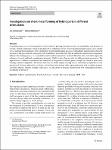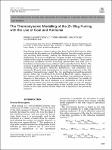Search
Author
- Amir, Ebrahimi (2)
- Aydin, Azizi (2)
- George, Haller (2)
- James, M. Fiore (2)
- next >
Subject
- Engineering (4)
- công nghệ (3)
- kỹ thuật (3)
- Robotics (3)
- next >
Date issued
Has File(s)
- true (215)
Search Results
A novel equal atomic Ni–Al-Ti-Mn-Co-Fe–Cr high entropy alloy (HEA) was developed via the spark plasma sintering (SPS) process. This study investigates the influence of the sintering parametric processes, which consist of the sintering temperature (ST) and heating rate (HR) at constant pressure and dwelling time (DT) on the Microhardness (MH) and relative density (RD) of the developed HEA. Response surface methodology (RSM) was used to develop a predictive model. The design of experiment (DOE) approach was adopted to reduce the number of experiments and eliminate trial by error. ST and HR were considered model variables in developing the model. The user-defined design (UDD) under RSM was used to predict the optimal sintering parameters, and an experiment was conducted to validate the... |
Conventional processes are being pushed to their limits by growing demands in terms of sustainability and diversity of variants. Hybrid components, which are produced by a combination of two or more manufacturing processes, are a suitable way of meeting these challenges. The combination of sheet metal forming processes with additive manufacturing offers the potential to link personalized components with standardized parts. Knowing that the additively manufactured components influence the forming process, it is essential to understand the interactions in detail. Therefore, this work will compare the influence of several additively manufactured elements (AME) for deep drawing with two different punch geometries. The approach used combines experimental and numerical investigations to i... |
Human cyber-physical systems present an appealing platform for facilitating human-centered computing, particularly in environments where humans are required to interact with systems comprised of cyber and physical layers. Universally accepted elements of a human cyber-physical system, and interactions among these elements, do not appear to emerge in literature. To address this, a human cyber-physical system architecture is offered, led by the seafaring focus of this study. A human cyber-physical system implementation, called Mariner 4.0, for monitoring motion sickness of seafarers is presented to demonstrate the operation of a human cyber-physical system as a platform for human-centered computing. The human cyber-physical system implementation enabled the digital representation of t... |
Slag fuming process is used to extract zinc from the lead blast furnace slags and recently for the extraction of multiple elements from the complex primary and recycling feed streams, making the thermochemistry of the process challenging. To meet new challenges, computer models with predictive powers outside of the range of normal process conditions are necessary. These models cannot rely exclusively on sets of existing process data and must have a foundation in thermodynamics combined with reasonable kinetic factors. The accuracy of predictions largely depends on the quality of thermodynamic data, including phase equilibria, elemental distributions, and calorimetry measurements. Present study demonstrates the recent developments of the self-consistent thermodynamic model for the ga... |
The current study investigates the stability structure of the base periodic motion of an inverted pendulum (IP). A uniform magnetic field affects the motion in the direction of the plane configuration. Furthermore, a non-conservative force as one that dampens air is considered. Its underlying equation of motion is derived from traditional analytical mechanics. The mathematical analysis is made simpler by substituting the Taylor theory in order to expand the restoring forces. The modified Homotopy perturbation method (HPM) is employed to achieve a roughly adequate regular result. To support the prior result, a numerical method based on the fourth-order Runge-Kutta method (RK4) is employed. The graphs for both the analytic and numerical solutions are highly consistent with one another... |





